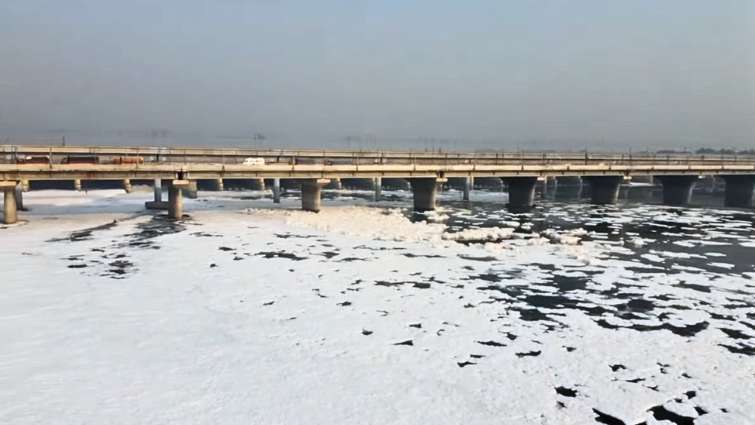Delhi की यमुना नदी में हर साल बढ़ता हुआ प्रदूषण बहुत चिंताजनक है। दिल्ली के निवासियों के लिए हवा की गुणवत्ता का गिरना और यमुना में जहरीले फोम का बनना, खासकर सर्दियों के आगमन के साथ, बड़े स्वास्थ्य खतरे पैदा कर रहे हैं। इस ब्लॉग में हम यमुना में प्रदूषण की वर्तमान स्थिति, इसके कारणों और संभावित उपायों पर चर्चा करेंगे।
यमुना नदी का प्रदूषण करने वाले प्रमुख कारक
Delhi के औद्योगिक और घरेलू अपशिष्ट का सीधे बहाव यमुना में बढ़ते प्रदूषण का सबसे बड़ा कारण है। दिल्ली प्रदूषण का 75% हिस्सा बनाती है, हालांकि यमुना नदी से सिर्फ 2% हिस्सा गुजरता है। अमोनिया (ammonia) और फॉस्फेट्स (phosphates) जैसे घातक रसायन, जो उद्योगों और सीवेज से निकलते हैं, इस समय यमुना में झाग पैदा कर रहे हैं।

यमुना में खतरनाक झाग: मानव स्वास्थ्य पर प्रभाव
नदी का स्वास्थ भी इस झाग से खराब होता है। इस झाग में मौजूद रसायन त्वचा को खराब करते हैं। विशेषज्ञों का कहना है कि दिल्ली (दिल्ली) में रहने वाले लोगों को लंबे समय तक सांस रोगों का सामना करना पड़ सकता है। विशेष रूप से उत्सवों, जैसे छठ पूजा, में लोग यमुना में स्नान करते समय इस झाग से सीधे संपर्क में आते हैं, इससे स्वास्थ्य समस्याएं हो सकती हैं
दिल्ली में वायु प्रदूषण की स्थिति और AQI
दिल्ली की हवा भी खराब है। दिल्ली (Delhi) का एयर क्वालिटी इंडेक्स (AQI) अक्टूबर 2024 में 300 से ऊपर चला गया, जिससे शहर को “बहुत खराब” श्रेणी दी गई है। यह स्थिति सर्दियों में और भी खराब हो जाती है जब हवा ठंडी हो जाती है और प्रदूषक कण जमीन के पास रह जाते हैं। Delhi के नेहरू प्लेस और आनंद विहार में भी दृश्यता कम हो गई है, जो वाहनों के लिए भी खतरनाक है।
यमुना को साफ करने के लिए किए गए उपाय
Delhi government ने यमुना को साफ करने के लिए कई उपाय किए हैं। इसमें डी-फोमिंग केमिकल्स का छिड़काव और बैराज गेट्स के खुलने की समय-सारणी की निगरानी शामिल है। हालाँकि, बहुत से लोग इन उपायों को कमजोर मानते हैं। पर्यावरणविदों और गैर सरकारी संगठनों का कहना है कि सीवेज ट्रीटमेंट प्लांट्स की क्षमता बढ़ाने और औद्योगिक अपशिष्टों पर कठोर नियंत्रण लगाने के बिना यह समस्या जारी रहेगी।
राजनीतिक उत्तर
यमुना में बढ़ते प्रदूषण के साथ-साथ राजनीतिक बहस भी बढ़ती जा रही है। भारतीय जनता पार्टी और आम आदमी पार्टी एक दूसरे पर आरोप लगा रहे हैं। बीजेपी कहता है कि दिल्ली सरकार ने पर्यावरण सुधार में कोई ठोस कदम नहीं उठाए हैं, जबकि आप कहते हैं कि केंद्र सरकार राज्य को इस विषय में मदद नहीं कर रही है।
क्या समाधान है?
- सीवेज ट्रीटमेंट प्लांट्स की क्षमता बढ़ाना: दिल्ली के अपशिष्ट का सीधा निपटान यमुना में होता है। सीवेज ट्रीटमेंट प्लांट्स को बेहतर और सक्षम बनाना आवश्यक है।
- औद्योगिक कचरे पर सख्त नियंत्रण: सभी उद्योगों को अपने कचरे का निपटान सही तरीके से करने के लिए बाध्य करना होगा।
- सार्वजनिक जागरूकता: लोगों को यमुना प्रदूषण के बारे में जागरूक करना और इसे कम करने के लिए व्यक्तिगत स्तर पर योगदान करने के लिए प्रेरित करना आवश्यक है।
- सरकारी कदमों की समीक्षा और सुधार: दिल्ली सरकार और केंद्र सरकार दोनों को इस समस्या पर ध्यान देना होगा और समन्वित प्रयास करने होंगे।
निष्कर्ष
Delhi की यमुना में प्रदूषण केवल एक पर्यावरणीय संकट नहीं है; यह जीवनशैली और स्वास्थ्य पर भी सीधा असर डालता है। जहरीली झाग और खराब हवा दिल्ली को खतरे में डाल रहे हैं। यमुना को फिर से साफ और सुरक्षित बनाने के लिए सरकारें, एनजीओ और आम लोगों को एकजुट होना चाहिए।
About Delhi Yamuna River
Delhi considers Yamuna River, one of its main tributaries to the Ganges, very important। It flows to Delhi from the Yamunotri Glacier in Uttarakhand and travels for about 1,376 kilometers। The ecology, economy, and culture of the area are all dependent on this river।
Cultural Importance
Yamuna in Delhi is more than just a river। millions of people are able to live on it। In Hindu culture, it has long been revered, often associated with purity and spirituality। Along its banks, many festivals and ceremonies are held, especially during occasions like Chhath Puja, when devotees gather to pray। temples and ghats adorn the riverbanks, where various rituals are performed, drawing connections between the city’s past and its present।
Economic Contributions
Delhi’s economy is heavily influenced by Yamuna। It provides essential irrigation, supporting agriculture in the nearby areas। The river is the main source of income for many communities, including fishing। Furthermore, the Yamuna supplies 70% of Delhi’s drinking water, which means that its health is essential for the city to survive। Nevertheless, the river’s pollution is a major problem that threatens its capacity to sustain the population।
Environmental Concerns
Despite its significance, Yamuna is facing pollution problems। Industrial waste and untreated sewage are discharged uncontrollably, resulting in a decline in water quality। According to reports, with only a small portion treated, more than 3,000 million liters of sewage are discharged into the river every day। Toxic foam is produced by this pollution, especially during winter when water levels fall. High ammonia and phosphate levels make this foam hazardous for human health and aquatic life। लंबी exposure can cause skin irritation and respiratory problems।
The Road Ahead
Restoring the Yamuna’s health requires collective efforts from the government, local communities, and environmental organizations. Enhanced infrastructure for sewage treatment, stricter regulations on industrial waste, and community engagement in river clean-up activities are essential steps toward a cleaner Yamuna.
Conclusion
The Yamuna River in Delhi is a vital resource with deep cultural, economic, and environmental significance. However, escalating pollution levels pose a serious threat to its integrity and the health of millions who depend on it. With collaborative efforts, it is possible to restore the Yamuna to its former glory, ensuring a sustainable future for Delhi and its residents.

